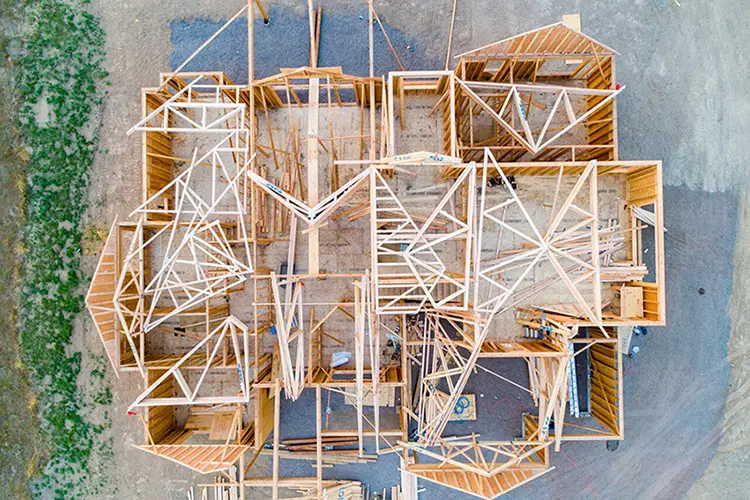5 Trends Impacting Construction Companies & Solutions To Stay Ahead

Anyone who doesn’t realize that the residential building industry is changing and evolving probably isn’t in the business. Yes, houses have looked much the same for as long as most of us can remember, but the process of constructing them and the business of managing that construction is not standing still. Technology today is accelerating the pace of change exponentially, just as economic trends are making it more and more important for construction companies to find solutions to protect their profitability in a competitive environment. Here are some of the trends affecting the industry right now and what you can do to keep up.
Trend #1: Challenge To Do More With Fewer Resources
Based on recent World Economic Forum reports, the construction sector is the largest global consumer of raw materials in the world. As we struggle to meet the needs of rapid population growth, global environmental resources are diminishing. At the same time, emissions from buildings and the construction industry are hitting all-time highs, accounting for nearly 40% of the world’s total carbon emissions.
These facts make the need for innovation in construction a matter not just of good business practices but of survival. Our sector needs to figure out how to consume fewer resources and prioritize sustainability. This requires new technology, new building materials and new sources of energy.
Trend #2: Rise of Equipment & Material Prices
Meanwhile, with scarcity and high demand, equipment and material prices continue to rise. Material shortages were increased by the coronavirus pandemic (COVID-19), but availability difficulties and cost increases are expected to persist. Residential construction is not a sector with huge profit margins that can easily absorb price increases. Companies must be more diligent than ever in analyzing and controlling their costs. They need to look deeply into every cost code and find ways to do more with less, eliminate waste and replace materials in short supply with those that are sustainable and more readily available. Lumber, steel and lighting supplies have been in short supply recently and the resulting price increases in steel and lumber have been steep, according to the Associated General Contractors of America.
Trend #3: Increased Focus on Harnessing Real-Time Data
Trends #1 and #2 are increasing the pressure on construction companies to make efficient business and financial decisions. An industry that has historically relied on experience-based guesstimates and seat-of-the-pants decision-making is now facing a growing need to harness real-time, detailed and actionable data.
What happens when projects are delayed because raw materials are unavailable when they are needed? How do companies avoid cost overruns when materials in short supply are more expensive than anticipated? Having access to data on past job costs, trends in materials costs, delivery options and ways to cut other project expenses can be the difference between making and losing money. Planning ahead, based on accurate job analyses, can even prevent some of these issues from occurring.

Trend #4: Technological Advancements in Materials and Processes
Although technology has been slower to affect construction than some other industries, it is making up for lost time. New building materials are being developed around the world that can reduce the use of raw resources — self-healing concrete, bricks that act as air filters; bricks made from cigarette butts; 3D printed plastics; hydroceramics; sustainable energy technology and much more. Prefabrication and modular construction, although they have been around for a while, are becoming more cost-effective and popular. Drones are being used to monitor sites and report on potential problems and progress.
Also, Building Information Modeling, or BIM technology, is growing in usage, even for residential construction, because of its clear benefits in saving time and money. BIM generates interactive digital models of the physical and functional characteristics of buildings. It enables better collaboration — project teams can work together more efficiently with all of the shared information in one place. Data collected can be analyzed and used to develop new, more efficient processes. BIM models can even be used to save money by purchasing materials in bulk and in advance of seasonal or inflation-related price hikes.
Innovation is necessary and beneficial, but it isn’t free. Construction companies face the challenge of incorporating technological innovations in their operations and construction techniques cost-effectively.
Trend #5: Embracing Project Management Software
Project management software has been adopted in many industries because it helps companies manage operations and finances more effectively. The trend has been slower to reach the residential construction industry because of the unique and complex nature of its needs. However, with the development of software designed specifically for residential home builders, contractors and subcontractors of all sizes, popularity and functionality are definitely on the rise.
The best project management software allows you to effectively manage your residential projects in one convenient system, from estimates and purchase orders through scheduling and crew dispatch, all the way through progress tracking, job costing, payments and invoicing. Combining cloud project management and financial management solutions in an integrated system that grants appropriate access to all team members offers transparency, accountability and efficiency that paper-based systems cannot match. This trend is, in fact, one of the most effective solutions to many of the challenges presented by other current trends in residential construction.
Stay Ahead With Hyphen HomeFront & Sage Intacct Construction
Hyphen HomeFront is a fully integrated residential construction ERP software allowing home builders to manage the build processes from sales and CRM to service and warranty in one easy-to-use system. With an on-premise construction ERP solution, there’s no need to replace your back-end accounting solutions.
This modern cloud financial management solution combined with Sage Intacct allows you to:
- Customize reporting and insights through customizable, real-time dashboards that are personalized for the user, department and entity
- Make continuous consolidations and hone in on specific entities, job sites, properties, etc.
- Streamline processes across all projects to create transactions in a way that meets your requirements, provides insight and complies with regulations
- Access reports and data anytime, anywhere
Interested in learning more about Hyphen HomeFront and how it can integrate with your current accounting software? View the recorded webinar or schedule a demo to talk to a Hyphen Solutions expert about how adopting Hyphen HomeFront gives you all the tools you need to build homes efficiently, sell homes quickly and enable your business to excel.

